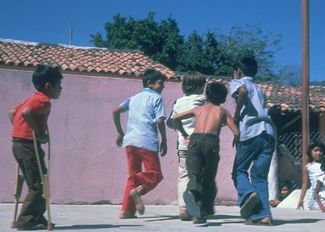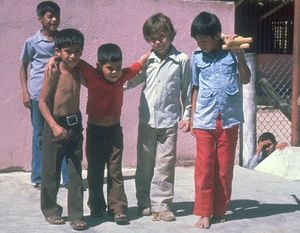Hesperian Health Guides
Understanding Children with Disabilities
HealthWiki > Disabled Village Children > Chapter 47: Helping Teachers and Children > Understanding Children with Disabilities

- Do you know any child who cannot walk or run or talk or play like other children?
- Why can’t this child do everything the same as you can?
- Is the child to blame?
- How do other children treat this child? Are they kind to him? Are they mean? Do they make fun of him? Do they include him in their games?
- How would you feel if you had a similar disability? How would you want other children to treat you? Would you like them to laugh at you? To pay no attention to you? To feel sorry for you? To do things with you and become your friend?
| Children will better understand the child with a disability if they can “put themselves in his shoes.” They can play a game in which one child pretends to have a physical disability. | The other children act out different ways of behaving toward the child. Some are friendly. Some ignore him. Some make fun of him. Some help him. Some include him in their games. Let the children think up their own ideas and act them out. | |
 For example, tie a stick to a child’s leg. Then have him run in a game or play tag. |
 |
After several minutes, another child can pretend to have a disability. Let several children have a turn. Try to make the pretend disability seem real.
Also ask the children what they might be able to do to make things better or fairer for the child with disabilities. Try or act out their different suggestions. For example:
 We could ask him to play games where his disability doesn't matter. |
 We could give each of us a "disability," or give him some advantage, so we could all be equal...like we could all tie our feet together!
We shouldn't laugh at him if he does things in a funny way, but encourage him to do his best, whatever way he can.
Caught you! |

For a more severe physical disability, the group of children can invent ways to “find out what it is like.” For example, to learn about a child with almost no use of her legs, the children might tie the legs of one of their group together, like this.

Then the children can ask the child to do some of their day-to-day activities—like moving around the house, going to the latrine, and going to school.

After talking with the child about her difficulties, the children can try to think of ways to make it easier for her to move about.
Note: With the help of their teacher or parents, children can, in fact, make simple wheelchairs and other aids for children with disabilities. For simple designs, see PART 3 of this book.

her a wheelchair out of an old chair and a couple of bike tires. My father's a carpenter and could
help us.

Help the children gain an understanding of the particular difficulties of children with disabilities in their village.
For example, if there is a child who has trouble walking because his knees press together, have a child try to walk with her knees tied together with a band of car tire inner tube.
 |
To appreciate the experience of a child who has trouble with balance due to cerebral palsy, have one of the children try to walk on a hanging board (or other moving surface). |

If there is a child with arthritis in the village, some of the children can put small stones in their shoes or tie small stones to the bottoms of their feet. Then the other children can invite them to run and play games. Ask the children why a child with arthritis might not want to play games.
Ask the children, “Do you know any children who cannot use their hands like you can?” If they answer yes, help them experience the difficulties of such a child. Have the children work in pairs.
| One child can wrap a strip of cloth around the other child’s hand and fingers so that he has trouble moving his fingers. |  |

Contents
Now have the child try to do things like:
- write
- turn pages of a book
- fill a cup with water
- eat
- get something from a pocket
- button a shirt
Have the children try to figure out ways to make it easier. For example, wrap cloth or a piece of inner tube around a pencil or spoon, to make it easier to hold.
 |
 |
| buttoning tool (See "Suggestions for Dressing"). |
Things that children with disabilities can do well

Try to have the children think of examples of things that children with disabilities can do well. Remind them that these children have a range of things they are good at, just like children who do not have disabilities.
A child with weak legs, who has to walk with crutches, often develops very strong arms and hands.
Or a child with loss of vision may learn to hear things extra well.
As with all children, with or without disabilities, it is best to recognize and encourage their strengths.
Swimming

Many children with weak or paralyzed legs can learn to swim well. Their arms become unusually strong from using crutches, and in the water they easily keep up with other children. But sometimes they have trouble getting to the water, or the other children forget to invite them...

A friendly word of welcome to include the child with a disability, or a little extra time or attention given to him, can make a big difference—and can make everyone feel good.
Role playing and children’s theater
To help see how much it matters to include children with disabilities in their fun, a group of children can act out different possibilities. For example, they might act out (or do a “role play” of) the pictures at the bottom of the page before this one. After the role play the group can discuss which of the two alternatives made the child with disabilities, and the other children, feel better, and why.
 |
 |
Or they can act out a situation in which they try to solve a particular difficulty, obstacle, or challenge.
In these ways the children will begin to use their imaginations to help solve problems.
If some of the children’s role plays turn out especially well, or do an extra good job at demonstrating important points, perhaps they can be developed further. Then the children can present them, in the form of skits or children’s theater, to other classes, parent groups, in the health center, or perhaps to the whole village.
(See examples of two skits which schoolchildren, together with health workers and rehabilitation workers with disabilities, put on in the village of Ajoya, Mexico.)




